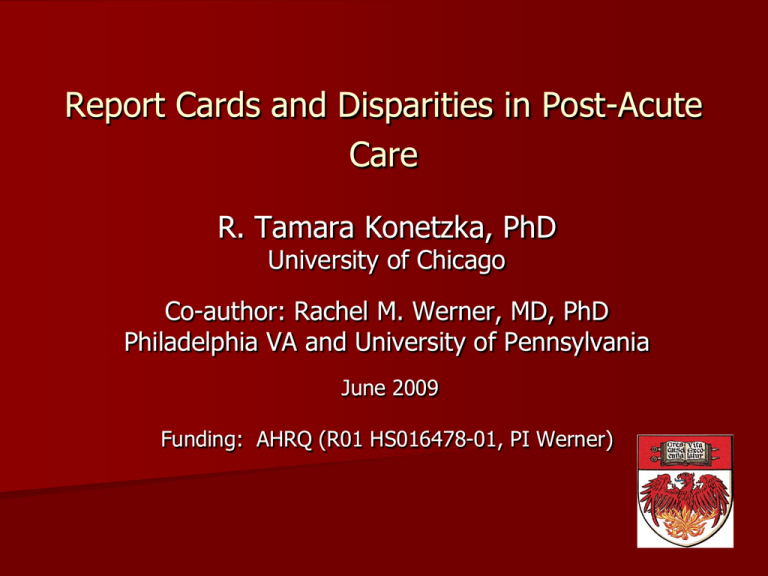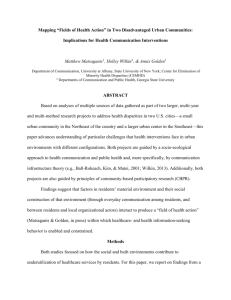Report Cards and Disparities in Post-Acute Care R. Tamara Konetzka, PhD
advertisement

Report Cards and Disparities in Post-Acute Care R. Tamara Konetzka, PhD University of Chicago Co-author: Rachel M. Werner, MD, PhD Philadelphia VA and University of Pennsylvania June 2009 Funding: AHRQ (R01 HS016478-01, PI Werner) Two National Health Care Priorities Improving the quality of health care 2. Reducing racial and ethnic disparities Can public reporting achieve both? Our goal is to answer this question empirically using evidence from postacute care 1. IOM: Differences, Disparities, and Discrimination: Populations with Equal Access to Health Care Clinical Appropriateness and Need Patient Preferences Minority Non-Minority Difference Populations with Equal Access to Health Care The Operation of Healthcare Systems and the Legal and Regulatory Climate Disparity Discrimination: Biases and Prejudice, Stereotyping, and Uncertainty Potential Effects of Public Reporting on Disparities Report cards may reduce disparities – Information may act as an “equalizer” among consumers – Low-quality providers have the greatest incentive to improve Report cards may increase disparities – Consumers have differential access to the information and ability to understand and use it – Supply – Low-quality providers may not have the resources to invest in quality improvement Background: Disparities in Nursing Home Care Nursing homes more segregated than other health care sectors, mirroring residential segregation Nursing homes in poor neighborhoods are lower quality and tend to… (Mor, 2004) – – – – – Be high Medicaid Be high minority Have more deficiencies Have lower staffing Be more likely to be terminated from Medicare/Medicaid Blacks and poorly educated patients more likely to enter low-quality facilities for post-acute care (Angelelli, Grabowski, Mor 2006) Specific Research Questions Do whites, blacks, and Hispanics benefit differentially from improvements in postacute care quality under NHC? To what extent is the differential improvement due to within-facility changes vs. changes in the site of care? Does education mediate these differences? Data Minimum Data Set (1999-2005) – Mandatory for all residents of Medicare- and Medicaid-certified nursing homes – Detailed assessment data – Source to calculate quality measures for Nursing Home Compare – Used to calculate quality measures over study period MedPAR – Claims data on all non-managed-care Medicare beneficiaries – Used to calculate rehospitalizations and several risk-adjustment variables OSCAR Race=black, white, hispanic 6.3 million admissions from 8,139 SNFs Reported quality measures Technical definitions of measures from CMS Follow CMS conventions – 14-day assessment – Resident exclusions from each measure – Facilities with more than 20 cases during target period Dependent Variables: Quality measures Measure Definition Mean (SD) No pain % of residents who did not have moderate or severe pain 76 (15) No delirium % of residents without delirium 96 (5) Improved walking % of residents whose walking improved Rehospitalization % of residents who had a rehospitalization within 30 days since last discharge 8 (7) 22 Race White (not hispanic) Black (not hispanic) Hispanic MDS instructions are to use self-report We omit Asian/Pacific Islander and Native American due to small sample sizes. Control variables For all regressions: – Age, gender, cognitive status, functional status, comorbidities, past admissions, BMI, end-stage disease, pain/delirium/walking upon admission For delirium: – Prior residential history (as specified by CMS for this measure) Education: less than high school; high school graduate; college graduate Empirical approach Qualityijt= β1NHCjt + ξ(NHCjtxRacei)+ θXit + ηj + εijt – Qualityijt = quality for individual i in SNF j in year t – NHCjt = indicator of Nursing Home Compare ▪ pre-post (1999-2002 vs. 2003-2005) ▪ set of year dummy variables – NHCjtxRacei = interactions between race and NHC – Xit = set of control variables – ηj = SNF fixed effects Percent of Residents Without Moderate/Severe Pain (adjusted) 0.77 0.765 0.76 0.755 black 0.75 hispanic w hite 0.745 0.74 0.735 0.73 Pre-NHC Post-NHC Percent of Residents Without Delirium -- adjusted 0.968 0.966 0.964 black 0.962 hispanic 0.96 w hite 0.958 0.956 0.954 Pre-NHC Post-NHC Without Moderate/Severe Pain upon Admission 0.84 0.82 0.8 0.78 0.76 black 0.74 0.72 0.7 0.68 0.66 0.64 hispanic white Pre-NHC Post-NHC Percent of Residents with a 14-Day Assessment 0.675 0.67 0.665 black 0.66 hispanic w hite 0.655 0.65 0.645 Pre-NHC Post-NHC Rehospitalizations, within-SNF, adjusted 0.245 0.24 0.235 black 0.23 hispanic 0.225 white 0.22 0.215 0.21 Pre-NHC Post-NHC Education Education does not mediate the effects Stratification by education produces similar results Consistent with most quality differences by race being due to site of care Conclusions No clear conclusions as to effects of NHC on disparities in post-acute care Use of 14-day assessments for quality measurement remains problematic Broader-based measures such as rehospitalization may be preferable





